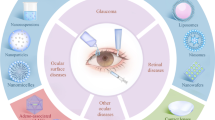Conclusions
In vivo ocular availability of ketorolac was evaluated following ocular instillation of aqueous, oil, and ointment formulations to normal corneas of rabbits and monitoring ketorolac concentration in aqueous humor by HPLC. Compared with aqueous drop, sesame and soybean oil drops of ketorolac provided higher ocular availability followed by ophthalmic ointment. The ointment formulation provided maximum sustained effect. Ketorolac aqueous drop with BAC and EDTA improved the rate of ocular absorption though not the extent.
Similar content being viewed by others
References
Herch PS, Rice BA, Baer JC, et al. Topical nonsteroidal agents and corneal wound healing.Arch Ophthalmol. 1990;108:577.
Cooper CA, Bergamini MVW, Leopold IH. Use of flurbiprofen to inhibit corneal neovascularization.Arch Ophthalmol. 1980; 98:1102–1105.
Kraff MC, Sanders DR, Mcguigan L, Rannan MG. Inhibition of blood-aqueous humor barrier breakdown with diclofenac: a fluorometric study.Arch Ophthalmol. 1990;108:380–383.
Searle AE, Pearce JL, Shaw DE. Topical use of indomethacin on the day of cataract surgery.Br J Ophthalmol. 1990;74:19.
Mahoney JM, Waterbury LD. (±) 5 benzoyl-1,2-dihydro-3H pyrrolo [1,2a] pyrrole-1-carboxylic acid (RS 37619]: a non irritating ophthalmic anti-inflammatory agent.Invest Ophthalmol Vis Sci. 1983;24:151–159.
Flach AJ, Kraff MC, Sanders DR, Tanenbaum L. The quantitative effect of 0.5% ketorolac tromethamine solution and 0.1% dexamethasone sodium phosphate solution on post surgical blood aqueous barrier.Arch Ophthalmol. 1998;106:480–483.
Heier J, Cheetham JK, Degryse R, et al. Ketorolac tromethamine 0.5% ophthalmic solution in the treatment of moderate to severe ocular inflammation, after cataract surgery: a randomized vehicle—controlled clinical trial.Am J Ophthalmol. 1999;127:253–259.
Solomen KD, Cheetham JK, Degryse R, Brint SF, Rosenthal A. Topical ketorolac tromethamine 0.5% ophthalmic solution in ocular inflammation after cataract surgery.Ophthalmology. 2001;108:331–337.
Fraser-Smith EB, Mathews TR. Effect of ketorolac onCandida albicans ocular infection in rabbit.Arch Ophthalmol. 1987; 105:264–267.
Fraser-Smith EB, Mathews TR. Effect of ketorolac onPseudomonas aeruginosa ocular infection in rabbits.J Ocul Pharmacol. 1988; 4:101–109.
Flach AJ, Dolan BJ, Irvine AR. Effectiveness of ketorolac tromethamine 0.5% ophthalmic solution for chronic aphakic and pseudoaphakic cystoid macular edema.Am J Ophthalmol. 1987;103:479–486.
Price FW Jr, Price MO, Zeh W, Dobbins K. Pain reduction after laser in situ keratomisleusis with ketorolac tromethamine ophthalmic solution 0.5%: a randomized, double-masked, placebo controlled trial.J Refract Surg. 2002;18:140–144.
Malhotra M, Majumdar DK. Effect of preservative, antioxidant and viscolizing agents on in vitro transcorneal permeation of ketorolac tromethamine.Indian J Exp Biol. 2002;40:555–559.
Malhotra M, Majumdar DK. In vitro transcorneal permeation of ketorolac from oil based ocular drops and ophthalmic ointment.Indian J Exp Biol. 1997;35:1324–1330.
Ling TL, Combs DL. Ocular bioavailability and tissue distribution of [14C] ketorolac tromethamine in rabbits.J Pharm Sci. 1987; 76:289–294.
Madhu C, Rix PJ, Shackleton MJ, Nguyen TG, Tang-Liu DDS. Effect of benzalkonium chloride/EDTA on the ocular bioavailability of ketorolac tromethamine following ocular instillations to normal and de-epithelized corneas of rabbits.J Pharm Sci. 1996;85:415–418.
Pharmacopoeia of India. 2nd ed. Delhi, India: Government of India, Ministry of Health and Family Welfare; 1970:203.
Fu RC, Lidgate DM. In vitro rabbit corneal permeability study of ketorolac tromethamine.Drug Dev Ind Pharm. 1986;12:2403–2430.
Grass GM, Wood RW, Robinson JR. Effects of calcium chelating agents on corneal permeability.Invest Ophthalmol Vis Sci. 1985;26:110.
Kennah HE, Higney S, Laux PE, Dorko JD, Barrow CS.Fundam Appl Toxicol. 1989;12:258–268.
Sieg JW, Robinson JR. Vehicle effects on ocular drug bioavailability 1. Evaluation of fluorometholone.J Pharm Sci. 1975;64:931.
Author information
Authors and Affiliations
Corresponding author
Additional information
Published: October 24, 2005
Rights and permissions
About this article
Cite this article
Malhotra, M., Majumdar, D.K. In vivo ocular availability of ketorolac following ocular instillations of aqueous, oil, and ointment formulations to normal corneas of rabbits: A technical note. AAPS PharmSciTech 6, 65 (2005). https://doi.org/10.1208/pt060365
Received:
Accepted:
DOI: https://doi.org/10.1208/pt060365




